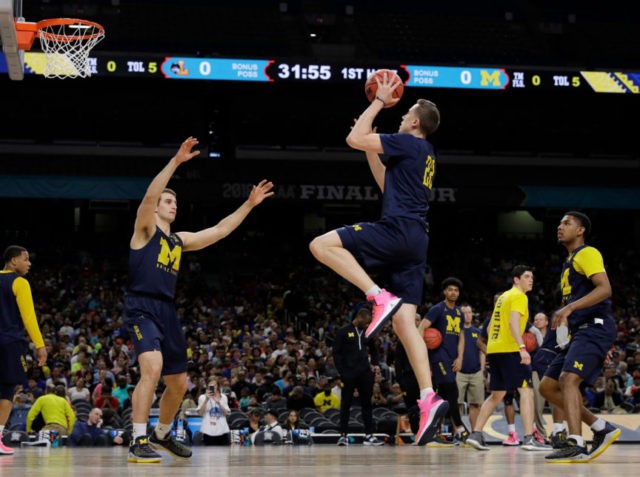SAN ANTONIO (AP) — The high-motion, position-less offenses are the shiny objects of this Final Four. Crisp passing, alley-oop dunks, cavalcades of 3-pointers — what’s not to like?
Behind the eye-catching, highlight-reel-inducing sparkle is a gritty underbelly.
Yep, defense.
One of sports’ deepest-rooted clichés is defense wins championships. Tired and not necessarily true, but it certainly doesn’t hurt.
The Final Four of Villanova, Kansas, Michigan and Loyola-Chicago all play different brands of D and it will be worth watching that side of the ball when they hit the floor Saturday in San Antonio.
A rundown:
___
MICHIGAN
The Wolverines had been the type of team that tried outscoring teams by raining 3-pointers. Defense was what always held them back.
No more.
Coach John Beilein has made defense a point of emphasis in recent years, and Michigan has become better for it. With the help of former Illinois assistant and defensive guru, Luke Yaklich, Beilein has transformed the Wolverines from one of the Big Ten’s worst defensive teams to one of the nation’s best.
While most teams have one, maybe two strong on-the-ball defenders, Michigan has three: Charles Matthews, Zavier Simpson and Muhammad-Ali Abdur-Rahkman.
The trio is quick, physical and good with their hands, making every move by ball handlers and cutters a chore.
German big man Moe Wagner is by no means a hulking presence inside, but he’s active, athletic and moves his feet well, allowing him to keep smaller players in front or soar in for backside blocks.
The Wolverines are No. 3 nationally in defensive efficiency and completely shut down an athletic Florida State team to reach the Final Four.
“If you do play good defense, it will give you a chance to win every day,” Beilein said.
VILLANOVA
The Wildcats lost a few games during the regular season they probably would like to have back, in part because their defense was nowhere near their uber-efficient offense.
Villanova’s run to a second Final Four in three years can be attributed, at least in part, to its increased ability to shut opponents down.
The Wildcats have long, athletic players with mostly interchangeable skills, allowing them to switch on screens a majority of the time. Mikal Bridges and Eric Paschall are versatile, so they can guard multiple positions and players of varied skills.
Big man Omari Spellman has become a better post defender and is more active after reshaping his body.
The Wildcats are holding teams to 36 percent shooting in the NCAA Tournament and are 14th in adjusted defensive efficiency, according to KenPom.com.
“They were so efficient offensively and picked up so many things that we were teaching offensively, that I thought it might be really tough to get them to be a good defensive team,” Villanova coach Jay Wright said. “They stuck with it and they’re becoming one of our best defensive teams, which I would have never thought midway through the season.”
LOYOLA-CHICAGO
As a mid-major team, the Ramblers are almost always undersized when going against Power Five schools.
They make up for it with discipline, tenacity and a commitment to coach Porter Moser’s methods.
Loyola’s perimeter players are active, have quick hands and often switch on the perimeter. The Ramblers also like to switch on ball screens and keep freshman center Cameron Krutwig, their last line of defense, in the paint.
Loyola is a superb transition defensive team because it rarely sends players to the offensive glass and triggers its own run-outs and transition 3-pointers with aggressive defense.
The Ramblers are 19th in adjusted defensive efficiency and have held their last 10 opponents to 68 points or less.
“It’s five guys, about being connected, working together to get a stop,” said Loyola guard Ben Richardson, the Missouri Valley Conference defensive player of the year. “We’re outsized in a lot of positions, but we have a lot of techniques to tap into to make up for the size.”
KANSAS
The Jayhawks, on paper, are the worst defensive team left in the bracket, coming in at 40th in adjusted D.
Kansas is exceptionally strong in one defensive area: Defending without fouling.
Because they don’t have a lot of depth, the Jayhawks can’t afford to foul a lot, but that also limits the number of easy points opponents get from free throws.
Udoka Azubuike is a load in the post at 7-foot, 280 pounds, and can soar in for backside blocks if a teammate gets beat. Svi Mykhailiuk showed off his defensive chops in the Elite Eight, when he repeatedly knocked Duke All-American Marvin Bagley III off the block and beat the freshman to his spots.
The Jayhawks also are playing harder after coach Bill Self called them soft midseason.
“I probably had verbally gotten after this team more and been more critical in some ways,” Self said. “But also with that being said, I think I’ve also made it real clear in many ways I’m more proud, too, because we have altered our personality traits to the point that it’s given this team the best chance.”
___
More AP college basketball: https://collegebasketball.ap.org ; https://twitter.com/AP_Top25 and https://www.podcastone.com/ap-sports-special-events

COMMENTS
Please let us know if you're having issues with commenting.